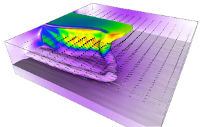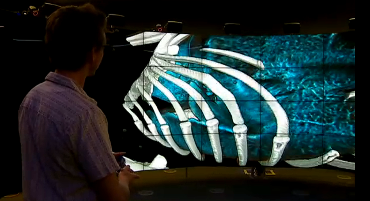What is IPython?¶
- IPython: interactive shell combining documentation, annotation, implementation(code) and publication
- Markdown formatted text, MathML formulae, images, video, HTML controls and components
- Lends itself very well to use with remote resources, virtual machines and containers.
Used increasingly widely in research for simulations, data analysis, machine learning and general research data processing


A 3d(4d) Visualisation library : developed for advanced visualisation facilities and next-generation HPC resources¶
- C++ backend with python interface wrapper provides a native OpenGL graphics layer to IPython
- HTML5 GUI: usable from IPython or stand-alone via the built in web server
- Geophysics: Underworld2 simulation code http://www.underworldcode.org/
- CAVE2: via LavaVR, cluster rendering and CAVE2 VR mode, Volumes, 4d data, Surface Models
- Output: still images, video animations, 3D interactive interfaces, 3D snapshots in WebGL.
Underworld: A parallel, particle-in-cell, finite element code for Geodynamics¶
Underworld is an open-source, particle-in-cell finite element code tuned for large-scale geodynamics simulations. The numerical algorithms allow the tracking of history information through the high-strain deformation associated with fluid flow.
The finite element mesh can be static or dynamic, but it is not constrained to move in lock-step with the evolving geometry of the fluid.
This hybrid approach is very well suited to complex fluids which is how the solid Earth behaves on a geological timescale.

Underworld2: python driven geophysics simulation http://www.underworldcode.org/¶
Underworld2 is a python-friendly rework of the Underworld code base which provides a programmable and flexible front end to all the functionality of the code running in a parallel HPC environment.
Underworld2 is integrated with the literate programming environment of the jupyter notebook system for tutorials and as a teaching tool for solid Earth geoscience.*
*https://github.com/underworldcode/underworld2

Underworld2 changes:¶
Problems addressed:
- Build and deployment: Docker
- Lack of flexibility and arcane XML model format: Python
- Difficult to learn and insufficient or out of date documentation: IPython
- No GUI features for visualisation: HTML5/CSS3/Javascript + IPython
LavaVu: a lightweight rendering library for scientific visualisation¶
https://github.com/okaluza/lavavu
- C++ powered A C++ OpenGL rendering engine compiled to a binary library
- Python Driven A Python interface wrapper module with underlying SWIG bindings and IPython supporting code
- Web GUI - JavaScript,HTML,CSS interactive components, including WebGL output
- JSON data for communication of state
- Numpy input for fast loading of native data arrays
CAVE2: Challenges of Virtual Reality Visualisation¶
Big data visualisation on CAVE2 and clustered display systems:¶
- Data processing: we have to pare down large datasets that can't be rendered at interactive framerates via interactively selecting, filtering, resampling, cropping data
- Then we can usually easily load a data set, but what next?
- Need the ability to control/explore data by modifying vis properties interactively

Why LavaVu?¶
What it does well:
- Use with the vast library of tools available in python
- Remote rendering and graphics on HPC systems while simulations are running using Mesa (software OpenGL)
- Server side render, client side control - via built in HTTP server and IPython.
- Correctly render transparency in large point swarms and surfaces
- Combined vis elements: volume/surface/point/line

Why LavaVu?¶
What it does well (cont.):
- Built for handling time-varying 4D data sets: simulation data
- IPython notebooks: analyse / visualise / process with IPython, instant vis results as part of the analysis workflow.
- CAVE2 and VR: pathway direct to CAVE2 with our VR module, LavaVR
- Scriptable image and video output, save and restore state, record and checkpoint stages of vis workflow
- Scriptable custom HTML5 GUI components

How to get it?¶
Github:
https://github.com/okaluza/lavavu
Instructions for building on Mac/Linux, including with IPython in the wiki:
https://github.com/okaluza/lavavu/wiki
Windows build: out of date due to lack of demand
Docker: (CPU and GPU versions to come) https://hub.docker.com/r/lavavu/latest/
Docker run on Linux with GPU access (open-source drivers only):
xhost +
docker run -v $HOME:/workspace/home -p 8888:8888 --volume=/tmp/.X11-unix:/tmp/.X11-unix --device=/dev/dri:/dev/dri --env="DISPLAY" lavavu/latest:v1.1How to use it?¶
Tutorials/Examples:
Other examples from CAVE2 projects:
Underworld simulation models:
Underworld model visualisation:

